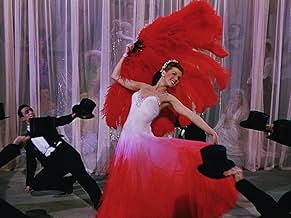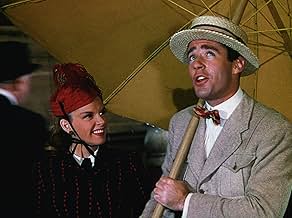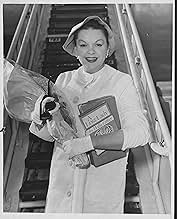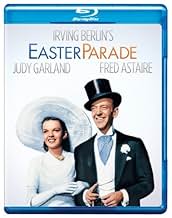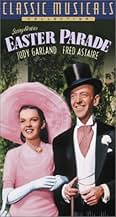NOTE IMDb
7,3/10
12 k
MA NOTE
Ajouter une intrigue dans votre langueA nightclub performer hires a naive chorus girl to become his new dance partner to make his former partner jealous and to prove he can make any partner a star.A nightclub performer hires a naive chorus girl to become his new dance partner to make his former partner jealous and to prove he can make any partner a star.A nightclub performer hires a naive chorus girl to become his new dance partner to make his former partner jealous and to prove he can make any partner a star.
- Réalisation
- Scénario
- Casting principal
- Récompensé par 1 Oscar
- 5 victoires au total
John Albright
- Western Union Messenger
- (non crédité)
Lola Albright
- Hat Model
- (non crédité)
- …
Don Anderson
- Passerby on Street
- (non crédité)
Shirley Ballard
- Showgirl
- (non crédité)
Norman S. Barker
- Trombone player in bar
- (non crédité)
Jimmy Bates
- Boy
- (non crédité)
Virginia Bates
- Model
- (non crédité)
Margaret Bert
- Florist
- (non crédité)
Lulu Mae Bohrman
- Restaurant Patron
- (non crédité)
Ralph Brooks
- Diner at Rooftop Show
- (non crédité)
Avis à la une
For those readers who favor Ann Miller's performance please forgive me, but no one can ignore the amazing performances of both Fred Astaire and Judy Garland in their only appearance on screen together. I just thought Ann Miller and Peter Lawford's performances were the fillers so that we the audience could take a breather in anticipation for Astaire and Garland's next on screen song and dance number together.
The color and cinematography in Easter Parade is second to none, even some seventy (72) plus years later. If for nothing else, please watch Fred Astaire perform his solo song and dance number early on in this film when he enters a toy store and attempts to purchase but first must grab a big stuffed toy rabbit from a young boy. This scene has Fred tap dancing his way into our living rooms like only he and maybe Gene Kelly (who had to turn this role down because he broke his ankle and was not available when filming began) could have done. This song and dance scene alone is worth the price of admission as the choreography and especially Astaire's uncanny ability to work his way through the toy store tap dancing, drumming, jumping, and singing in this one scene is simply pure entertainment.
I give it a 7 out of 10 IMDB rating.
The color and cinematography in Easter Parade is second to none, even some seventy (72) plus years later. If for nothing else, please watch Fred Astaire perform his solo song and dance number early on in this film when he enters a toy store and attempts to purchase but first must grab a big stuffed toy rabbit from a young boy. This scene has Fred tap dancing his way into our living rooms like only he and maybe Gene Kelly (who had to turn this role down because he broke his ankle and was not available when filming began) could have done. This song and dance scene alone is worth the price of admission as the choreography and especially Astaire's uncanny ability to work his way through the toy store tap dancing, drumming, jumping, and singing in this one scene is simply pure entertainment.
I give it a 7 out of 10 IMDB rating.
There's an incredible backstory behind Easter Parade. Fred Astaire had announced his retirement from movies, and Gene Kelly was attached to the new Judy Garland musical set at Eastertime. Then, Gene experienced every dancer's nightmare and broke his leg. He called Fred up and asked if he'd take his place. And now we have Easter Parade!
Now that you know Gene Kelly was supposed to play the lead, it's understandable that he was supposed to sing the seductive "It Only Happens When I Dance with You" to Ann Miller. How would Fred Astaire handle it? He's not usually marketed as having much sex appeal. Well, move over Gene Kelly; Fred's just fine. In fact, although there are plenty of great numbers in Easter Parade, that one's my favorite because of the different tone Fred takes with himself.
There are quite a few famous songs from this movie, most notably the performance Fred and Judy give dressed like bums: "A Couple of Swells". Peter Lawford plays the other man in both love triangles-although who would ever pick him over Fred Astaire?-and he gets to sing the cute "A Fella with an Umbrella" when he meets Judy Garland. "Steppin' Out with My Baby" is another performance on the stage-Fred's character is a performer looking for a new partner-that utilizes groundbreaking camerawork that's still fantastic to watch. Fred dances in slow motion while the chorus girls behind him move in regular time, and the layered look is jaw-droppingly innovative for 1948.
I've praised several of Irving Berlin's songs from the movie, but they're not all fantastic. "I was born in Michigan, and I wish and wish again. . ." is a lyric from one of the silly songs Judy has to sing. So, while there will be a few scenes that will make you cringe and leave the room for more popcorn, most of the movie is pretty fun to watch. I own a copy, and we watch it every few years on Easter when we want a break from our usual Ben-Hur. I always like Fred Astaire's movies, so it has to be really stinky for me to not recommend it. I mean, who else but Fred can walk into a toy store and turn the toys into a dance number? Watch his dance "Drum Crazy" in Easter Parade and ask him through the television why he bothered trying to retire.
Now that you know Gene Kelly was supposed to play the lead, it's understandable that he was supposed to sing the seductive "It Only Happens When I Dance with You" to Ann Miller. How would Fred Astaire handle it? He's not usually marketed as having much sex appeal. Well, move over Gene Kelly; Fred's just fine. In fact, although there are plenty of great numbers in Easter Parade, that one's my favorite because of the different tone Fred takes with himself.
There are quite a few famous songs from this movie, most notably the performance Fred and Judy give dressed like bums: "A Couple of Swells". Peter Lawford plays the other man in both love triangles-although who would ever pick him over Fred Astaire?-and he gets to sing the cute "A Fella with an Umbrella" when he meets Judy Garland. "Steppin' Out with My Baby" is another performance on the stage-Fred's character is a performer looking for a new partner-that utilizes groundbreaking camerawork that's still fantastic to watch. Fred dances in slow motion while the chorus girls behind him move in regular time, and the layered look is jaw-droppingly innovative for 1948.
I've praised several of Irving Berlin's songs from the movie, but they're not all fantastic. "I was born in Michigan, and I wish and wish again. . ." is a lyric from one of the silly songs Judy has to sing. So, while there will be a few scenes that will make you cringe and leave the room for more popcorn, most of the movie is pretty fun to watch. I own a copy, and we watch it every few years on Easter when we want a break from our usual Ben-Hur. I always like Fred Astaire's movies, so it has to be really stinky for me to not recommend it. I mean, who else but Fred can walk into a toy store and turn the toys into a dance number? Watch his dance "Drum Crazy" in Easter Parade and ask him through the television why he bothered trying to retire.
Originally intended as a re-teaming of Judy Garland and Gene Kelly, EASTER PARADE ran into trouble when Garland's doctors advised against her working under the direction of her husband, director Vincent Minnelli--and no sooner did director Charles Walters take the helm than Gene Kelly broke his leg. Out of such confusion are movie musical miracles born: although a bit old to act as Garland's leading man, Fred Astaire was coaxed out of retirement. He and Garland had tremendous chemistry, EASTER PARADE was a box office smash, and Astaire unexpectedly found himself reborn as an MGM star.
Set in 1900s New York, the film's story line is flimsy but enjoyable. After long-time dance partner Ann Miller abandons the act, Astaire hires chorus girl Garland and attempts to recast her in his former partner's mold--a situation which offers Astaire and Garland considerable comedy and gives Astaire the chance to parody several of his own famous dance of the 1930s. Garland eventually convinces Astaire that she needs to be herself, and once the act is revamped they become a hot ticket--and, once their several romantic complications are resolved, romantic partners as well.
Astaire is every bit as charming here as he was in his Ginger Roger days, and his choreography retains his signature sharpness, wit, and elegance. Although Garland isn't really a dancer, she holds her own with Astaire and she tears strips off a brilliant score of Irving Berlin favorites. Both are well supported by Anne Miller, who gives a brilliant turn with 'Shakin' the Blues Away,' and Peter Lawford, who is quite charming as one of Garland's admirers. Although this really isn't as inspired as the truly great MGM musicals of the late 1940s, director Walters keeps it going at a smart pace, and the star power, clever script, memorable score, and those legendary MGM production values elevate it well above the pack. Musical fans will be in for a treat! Recommended.
Gary F. Taylor, aka GFT, Amazon Reviewer
Set in 1900s New York, the film's story line is flimsy but enjoyable. After long-time dance partner Ann Miller abandons the act, Astaire hires chorus girl Garland and attempts to recast her in his former partner's mold--a situation which offers Astaire and Garland considerable comedy and gives Astaire the chance to parody several of his own famous dance of the 1930s. Garland eventually convinces Astaire that she needs to be herself, and once the act is revamped they become a hot ticket--and, once their several romantic complications are resolved, romantic partners as well.
Astaire is every bit as charming here as he was in his Ginger Roger days, and his choreography retains his signature sharpness, wit, and elegance. Although Garland isn't really a dancer, she holds her own with Astaire and she tears strips off a brilliant score of Irving Berlin favorites. Both are well supported by Anne Miller, who gives a brilliant turn with 'Shakin' the Blues Away,' and Peter Lawford, who is quite charming as one of Garland's admirers. Although this really isn't as inspired as the truly great MGM musicals of the late 1940s, director Walters keeps it going at a smart pace, and the star power, clever script, memorable score, and those legendary MGM production values elevate it well above the pack. Musical fans will be in for a treat! Recommended.
Gary F. Taylor, aka GFT, Amazon Reviewer
For the only teaming of Fred Astaire and Judy Garland, Gene Kelly had to break an ankle playing touch football although he told the studio it was in rehearsal. So Fred Astaire who after another Irving Berlin musical extravaganza, Blue Skies at Paramount, got pulled out of retirement for this film. It was a happy accident for film fans.
Easter Parade by this time had become the national anthem for Easter and enjoys a grand seasonal popularity as Irving Berlin's White Christmas also. It was originally written for the musical revue As Thousands Cheer in 1933 and sung as a duet by Clifton Webb and Marilyn Miller. Bing Crosby reprised it in Holiday Inn in a very nice number driving a horsedrawn sleigh from church Easter services. But usually when it is presented visually, the clip of Judy Garland singing it in the finale is the one always shown.
By the way the melody originally was for a lyric entitled Smile and Show Your Dimple which bombed for Irving Berlin. Berlin was quoted as saying that popular songs are a perfect marriage between words and music and in this case the melody got divorced and married a second lyric successfully.
Easter Parade is a good mixture of old Irving Berlin material and new songs written for this film. Fred Astaire shines with one of the new ones in Stepping Out With My Baby which is a good followup to Putting On the Ritz which Astaire sang and danced to in Blue Skies. And Judy just shines in Better Luck Next Time.
The plot is a pretty simple one and for the MGM opulence that their musicals were known for their are very few actual speaking roles in this film. It's a romantic quadrangle with Fred Astaire being dumped by his erstwhile partner Ann Miller and then taking on Judy Garland in one of those 'I'll show her' moments of bravado. Peter Lawford's around to get whoever Astaire doesn't.
The acting honors in Easter Parade go to Judy. For all that talent Judy Garland was a most insecure person in life and she drew from that in bringing Hannah Brown to the screen.
Ann Miller's big number is Shaking the Blues Away which Ruth Etting introduced in 1927. Doris Day in fact does it in Love Me or Leave Me. Still Ann makes it more of a dance number than Doris did which is what Irving Berlin originally intended it to be.
The thing about Easter Parade and so many other films like it is that all that talent was contracted to that studio. You can't make a film like Easter Parade today because you'd have to pay full market price for the talent, even as Irving Berlin's numbers slip year after year into public domain.
The Easter parade with women dressed in their finest most tasteful frock is still a New York tradition on Easter Sunday. So is this film.
Easter Parade by this time had become the national anthem for Easter and enjoys a grand seasonal popularity as Irving Berlin's White Christmas also. It was originally written for the musical revue As Thousands Cheer in 1933 and sung as a duet by Clifton Webb and Marilyn Miller. Bing Crosby reprised it in Holiday Inn in a very nice number driving a horsedrawn sleigh from church Easter services. But usually when it is presented visually, the clip of Judy Garland singing it in the finale is the one always shown.
By the way the melody originally was for a lyric entitled Smile and Show Your Dimple which bombed for Irving Berlin. Berlin was quoted as saying that popular songs are a perfect marriage between words and music and in this case the melody got divorced and married a second lyric successfully.
Easter Parade is a good mixture of old Irving Berlin material and new songs written for this film. Fred Astaire shines with one of the new ones in Stepping Out With My Baby which is a good followup to Putting On the Ritz which Astaire sang and danced to in Blue Skies. And Judy just shines in Better Luck Next Time.
The plot is a pretty simple one and for the MGM opulence that their musicals were known for their are very few actual speaking roles in this film. It's a romantic quadrangle with Fred Astaire being dumped by his erstwhile partner Ann Miller and then taking on Judy Garland in one of those 'I'll show her' moments of bravado. Peter Lawford's around to get whoever Astaire doesn't.
The acting honors in Easter Parade go to Judy. For all that talent Judy Garland was a most insecure person in life and she drew from that in bringing Hannah Brown to the screen.
Ann Miller's big number is Shaking the Blues Away which Ruth Etting introduced in 1927. Doris Day in fact does it in Love Me or Leave Me. Still Ann makes it more of a dance number than Doris did which is what Irving Berlin originally intended it to be.
The thing about Easter Parade and so many other films like it is that all that talent was contracted to that studio. You can't make a film like Easter Parade today because you'd have to pay full market price for the talent, even as Irving Berlin's numbers slip year after year into public domain.
The Easter parade with women dressed in their finest most tasteful frock is still a New York tradition on Easter Sunday. So is this film.
Yes, this movie, arguably one of Garland's best at M-G-M, is certainly something to look at. Cute story, excellent cast, gorgeous costumes (Ann's breathtaking white and red gown from the Magazine Cover number and Judy's marvelous emerald-coloured dress at the Ziegfeld Follies after opening night), and have I mentiond the SWELL songs? Drum Crazy is awfully entertaining, Shakin' the Blues Away is classic Miller (in other words fast and superb), Better Luck Next Time is heartbreaking, and so many others are just plain GOOD. A must see for any fans of Judy Garland, Fred Astaire, Ann Miller, Peter Lawford, Jules Munshin (in a funny bit as a waiter), or just great fun.
Le saviez-vous
- AnecdotesGene Kelly was originally scheduled to play Don, but he broke his ankle playing volleyball in his backyard. It was his suggestion that he be replaced by Fred Astaire. Cyd Charisse was up for the role of Nadine, but a torn ligament in either one or both of her knees forced her to drop out. She was replaced by Ann Miller.
- GaffesA Police officer writes Jonathan (Peter Lawford) a ticket for parking beside a fire hydrant. As he hands over the ticket, he bumps the hydrant which wobbles.
- Versions alternativesThere is an Italian edition of this film on DVD, re-edited in double version (1.33:1 and 1.78:1) with the contribution of film historian Riccardo Cusin. This version is also available for streaming on some platforms.
- ConnexionsEdited into Histoire(s) du cinéma: Seul le cinéma (1994)
- Bandes originalesHappy Easter
(uncredited)
Written by Irving Berlin
Performed by Fred Astaire
Performed also by Fred Astaire and Judy Garland
Meilleurs choix
Connectez-vous pour évaluer et suivre la liste de favoris afin de recevoir des recommandations personnalisées
- How long is Easter Parade?Alimenté par Alexa
Détails
- Date de sortie
- Pays d’origine
- Langues
- Aussi connu sous le nom de
- Desfile de Pascua
- Lieux de tournage
- Société de production
- Voir plus de crédits d'entreprise sur IMDbPro
Box-office
- Budget
- 2 503 654 $US (estimé)
- Montant brut mondial
- 1 605 $US
- Durée
- 1h 43min(103 min)
- Rapport de forme
- 1.37 : 1
Contribuer à cette page
Suggérer une modification ou ajouter du contenu manquant







